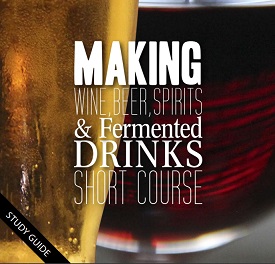Study Brewing and Fermentation
- Learn to make Beer, wine and spirits
- Understand fermentation processes
- Discover how to make probiotic and non alcoholic fermented drinks

Sneak Peek
Course Duration: 20 hours of self paced study
Course Lessons
There are ten lessons in this course:
Lesson 1: HISTORY, SCOPE AND NATURE OF ALCOHOLIC DRINKS
- A Brief History
- Trends in Beverage Consumption
- Alcohol & Health
- Global Wine Production
- Global Wine Consumption
- Global Beer Production
- Global Beer Consumption
- Good Quality Water
Lesson 2: THE SCIENCE: CHEMICAL & MICROBIOLOGICAL PROCESSES
- Understanding the Science
- Fermentation
- Glycolysis
- Carbohydrates
- a) Monosaccharides
- c) Polysaccharides
- Microbiology
- Yeasts
- Enzymes
- Effect of Temperature
- Effect of pH
- Spoilage
Lesson 3: PROBIOTIC DRINKS
- The Benefits of Probiotics
- Kefir
- Making Kefir
- Variations
- Other Uses for Kefir
- Reducing Alcohol Content
- Storage and Reuse
- Long Term Storage
- To Feed the Kefir Culture
- Kombucha
- Making Kambucha step by step
- Beet Kvass
Lesson 4: BREWING BEERS
- What Can Be Brewed?
- Water: The Essential Ingredient
- The Water Profile
- Example of a Commercial Brewing Process
- Brewing Using Different Methods
- Open Brewing/Fermentation
- Closed Brewing
- Fermentation Temperatures
- Spontaneous Brewing
- Barrel Aging
- Old Brewing Techniques
- Double Dropping/Dropping System
- Cleansing System
- Skimming System
- The Yorkshire Square Brewing Method
- Using Hops in Brewing
Lesson 5: BREWING CIDERS
- Traditional Cider
- Fruit Ciders
- Apple and Pear Fruits
- Making Apple or Pear Cider
- Equipment - What You Will Need
- The Wild Yeast Method
- Heat Treated Method
Lesson 6: MEAD
- Making Mead
- Preparing to Make Mead
- Ingredients
- Making the Mead
- Examples of Different Types of Mead
Lesson 7: WINE
- What Is Involved In Winemaking?
- An Overview of Some Winemaking Terms
- An Overview of Winemaking Processes
- The Importance of Yeast
- The Fermentation Process in Detail
- Containers
- Sweetness
- Malolactic Fermentation
- Red and White Winemaking
- A Winemaking Method for Some Wines
- Preparing to Ferment
- Types of Wine
- Red Wines
- White Wines
- Rosé Wine
- Sparkling Wine
- Fortified Wines
- A Glossary of Terms for Wine Making
Lesson 8: SPIRITS AND FORTIFIED WINES
- Distillation
- Spirits
- Spirit Groups
- Brandy
- Whisky
- Gin
- Rum
- Vodka
- Tequila
- Liqueurs
- Liqueur Groups
- Aperitifs
- Sherry
- Vermouth
- Port
- Gin Making – A Simple Approach
Lesson 9: NO OR LOW ALCOHOL BREWED DRINKS
- Brief History of Non-alcoholic Drinks
- Reasons to Choose Low or No-Alcohol Drinks
- Alcohol Content
- How to Remove Alcohol after Brewing
- Beers
- Wine
Lesson 10: OTHER VARIATIONS ON BREWED DRINKS: GETTING INVENTIVE
- Mixed Drinks & Cocktails
- Mixed Drinks
- Cocktails
- Making Mixed Drinks & Cocktails
- The Art of Brewing
- Ingredients
- Equipment
- Getting Inspiration from Around the World
- Final Assessment
LEARN WHAT IS POSSIBLE
Brewing and winemaking is based on one simple biochemical reaction that converts sugar to alcohol. When a sugar (such as fructose or glucose) is combined with yeast bacteria and allowed to ferment it changes form to produce ethyl alcohol plus carbon dioxide and energy.
On an amateur level, individuals can and do make wine, beer and other alcoholic drinks at home and on a small scale. Often breweries and wineries may start as a small scale or even home based operation, but to become viable and sustainable in the longer term, they inevitably are likely to become more than a one person operation.
On a commercial level, commercial breweries and wineries become complex environments. Large operations employ microbiologists who have a sound knowledge of fermentation processes and the biochemistry involved. Microbiology as applied to brewing incorporates knowing how microbes behave and how metabolites influence the properties of beverages. A good grounding in food science is also beneficial. Another aspect which is more practical is having good sensory skills for detecting problems with taste and flavour. Many microbiologists develop a sense for smelling different types of yeast. Microbiologists must be able to determine when a microorganism poses a threat to brewing.
This course develops a broad foundation that can underpin either amateur or professional winemaking and brewing. It is a ver4y solid starting point for either, or can even provide a solid training program for someone who lacks any sort of formal training in the subject, but has been employed to work at a brewery or winery.
CERTIFICATE OF COMPLETION
On successful completion of short online tests at the end of each lesson, plus a longer online exam at the conclusion of the course; you may be awarded a certificate of completion.
WHO IS THIS COURSE INTENDED FOR?
- Professional development or staff training for anyone who works in brewing or wine making.
- Anyone working in wholesaling or retailing of brewed drinks -
this course provides a deeper product knowledge and can be valuable
training for business owners and staff alike.
- Anyone seeking to fill in gaps in their own knowledge.
- Anyone with a passion for brewing or wine making.